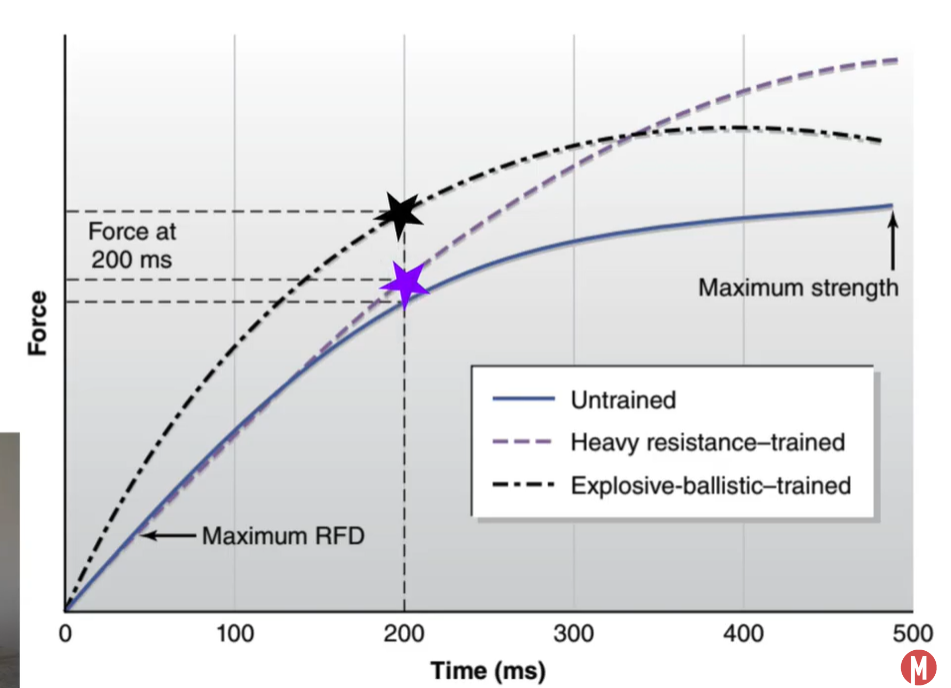CSCS Rate of Force Development
Jul 02, 2022Edited by: Danielle Abel
Rate of force development affects training in 2 ways:
- Low velocity training
- High velocity training
As a coach, you also need to be mindful of max force vs. max rate of force development when programming training for athletes. Rate of force development simply refers to how quickly an athlete can produce force.
Keep in mind different athletes, based on their sport, training age, and training logic, will produce force differently. For example, an untrained individual will produce force more slowly compared to an athlete who has trained with explosive ballistic movements. The following graph depicts how different athletes produce force.

Graph key:
X-Axis: Time (0 seconds to .5 seconds)
Y- Axis: Force
Colored Lines: Different type of athletes
(Steeper the line= quicker an athlete can develop force)
Black dotted line (explosive-ballistic-trained): Basketball players & sprinters, for example produce a lot of force in a short amount of time
Purple dashed line (heavy-resistance): Powerlifters for example, produce a lot of maximal force, but less rate of force development
Blue solid line (untrained): General population, in general, have a low rate of force development and low max strength
Box Jumps
Let’s look at a box jump, for example. The powerlifter can produce more total force. However, a box jump movement only gives you .2-.3 seconds of ground contact time to produce that force.
If you follow up the .2 second mark, you can see the basketball player will be able to do a higher box jump because they can produce more force during a shorter window of time.
1RM Squat
In comparison to a 1RM squat, it takes 2-3 seconds to get up from a squat. The powerlifter can produce more power during this window since it is a longer time frame.
Training an Explosive Athlete
For our sprinter, during their acceleration phase, they will have .2-.4 seconds of ground reaction time with each foot contact. As they get faster, that ground contact time will shorten to ~.1 seconds of ground contact time.
This means the athlete will have a shortened time frame to put force into the ground, placing high importance on the high rate of force development.
- Box jumps
- Depth jumps
- Power skips
For our basketball player who wants to jump higher, the focus of their training will also be on rate of force development including plyometrics, dynamic effort lifts, and medicine ball throws. These quick forceful movements will emphasize adaptations that drive up the slope at the beginning of the graph. Some max effort type lifts are still important during the off-season.
Training an Endurance Athlete
While working with a cross country or endurance athlete, they do not need to produce high rates of force development. Instead, they need to produce sustained effort.
Therefore, we might choose activities with a lower rate of force development for training.
- Tempo Squats
- Nordic Hamstring Curls
- Bench Press
Some plyometrics for mechanics of accepting load and introducing the stretch-shortening cycle are still important. However, this is not a primary adaptation for this athlete. In fact, it may be detrimental to do too much rate of force development training because then they will generate force quickly and it will dissipate quickly.
We want our endurance athletes to produce force relatively slowly and maintain it longer.
Athletic Movements & Maximal Force
Overall, most athletic movements occur too fast to produce maximal force. It takes about .6-.8 seconds to produce maximal force, whereas most athletic movements are faster than this:
- Max velocity sprinting: .09-.12 seconds
- Changing direction: .4-.7 seconds
- Acceleration phase of sprinting: .2 seconds
Support & Courses Available
Ready for more support to help you prep for the CSCS exam? Join our Facebook Group, “Strength and Conditioning Study Group,” here. Ready for even more? Our 24-module CSCS Prep Course has biomechanics completely laid out for you with even more content than what we’ve provided here, plus chapter quizzes to help you pass the NSCA exam; click the link here to check it out.
Stay connected with news and updates!
Join our mailing list to receive the latest news and updates from our team.
Don't worry, your information will not be shared.
We hate SPAM. We will never sell your information, for any reason.

